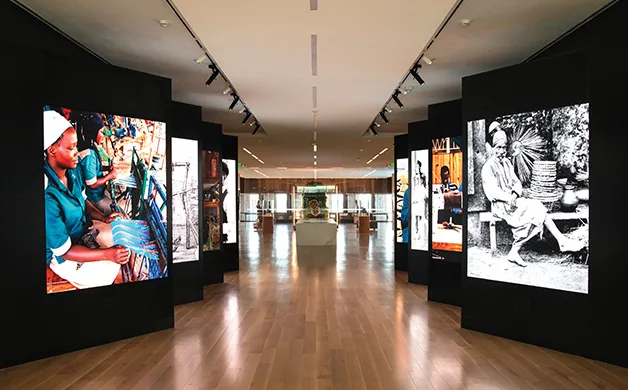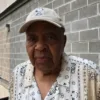
The International African American Museum (IAAM) in Charleston
sits atop rounded pillars that keep the structure itself from touching the
ground at Gadsden’s
Wharf.
There’s
a reason for that – IAAM’s architect, the late Henry N. Cobb, considered the site
“hallowed ground” because it was the entry point for the
untold thousands of Africans who were brought to South Carolina as slaves, many
of whom died there soon after arrival.
The histories of Charleston and the North American slave trade
are inextricably woven together, and those threads are visible from the moment
a visitor steps foot onto the IAAM campus.
A reflective black marble wall features a poem by Maya Angelou
that concludes, “I rise, I rise, I rise,” and is flanked by abstract
kneeling figures sculpted from concrete.
Nearby, a brick outline traces the dimensions of the storage
house where enslaved individuals were kept before being sold at auction. The
conditions there were primitive, and many men, women, and children did not
survive that house.
A fountain facing the wharf contains outlines of human figures
caught between the ports of departure from Africa and the North and South
American ports of arrival, the water rising and falling with the tides.
Charleston is a crucial part of the American experience with
slavery because approximately half of the African people brought here as slaves
came through the Lowcountry. The museum, which opened to the public in late
June, is the second-largest African American museum in the country, behind the
Smithsonian, said Tonya M. Matthews, Ph.D., the museum’s president and CEO.
While the IAAM offers the chance for visitors to see artifacts
from across the world, the museum experience seeks to do more than showcase
centuries-old items. The experience offers the African diaspora as a foundation
for exploring the wider world, from pre-history to the present.
The fountain helps to set the scene, but the museum’s interior brings to life a
multitude of stories that flow out from a common source.
The tour begins with an 18-minute film about the Transatlantic
experience, which blends still photographs and video images to “give
you a sense of all of the themes in the museum,” Matthews. “It
will run all the way from, say, Timbuktu, ancient civilizations (and) it will
come up to the period of slavery, and it keeps on going.”
The international component is evident from this first moment of
entry, carrying visitors through the displays, from an exhibit about the first
recorded instance of human rice cultivation thousands of years ago, to a
14th-century carved headpiece from the Yoruba region of what is now Nigeria, to
modern-day sweetgrass baskets woven in South Carolina.
“You run through all of the emotions” in that
introductory film, “and that’s what this space is for, to give you a hint of
everything that you’re
going to see,” Matthews said.
There is a gallery paying tribute to the Gullah and Geechee
culture centered in South Carolina’s Lowcountry, and another one called “African
Roots and Routes,” which traces the many paths that individuals of African
descent have taken throughout the world, and the lasting impressions that their
cultures made on the world at large.
Another area of the museum lays out the stark human cost of the
slave trade, illuminating the lives lost on slave ship voyages to the Americas,
the estimated number of individuals who passed through Charleston, and many of
the African people whose names were changed after they were purchased by slave
owners.
One wall lists names and ages of people such as Oobah, age 16;
Manmoque, age 21; and Kiabree, age 18, who arrived on slave ships. Another wall
spotlights individual names taken from slave records of plantations, people
with names such as Jack, Bella, Hagar, and Old Venus.
According to the museum, more than 150,000 people from Africa
arrived in the Charleston area between 1710 and 1808, on voyages that averaged
63 days.
In addition to the artifacts, films, and historical elements, the
museum is home to a genealogy research center, the Center for Family History.
Researchers are on staff to help visitors trace their ancestry, through
connections to some of the world’s largest genealogy databases, Matthews said.
The museum’s blend of themes and artifacts showcases the vast range
of emotions key to the history of African Americans across the centuries.
“It’s interesting the way human emotions work. There are
certain things, I think, that are more visceral than others,” Matthews said,
comparing small personal items that belonged to individual enslaved people with
the large numbers associated with the slave trade.
The stories that are told at IAAM are large in scale – the
international slave trade – but there are smaller stories, too, illuminating
moments in the lives of the individuals who spent their lives in the shackles
of slavery, and of the people who made history in the nearly 160 years since
the Emancipation Proclamation declared the end of slavery.
“The idea is to spark curiosity, spark inspiration,”
hoping that visitors leave the museum with questions that can be answered by
more research and reading, Matthews said.
Matthews said she isn’t trying to evoke one particular feeling for visitors,
but rather the spectrum of emotions threaded through African American history
and the experiences of individual African Americans through the generations.
“The greatest gift of the African American journey is its
ability to teach the way that we simultaneously hold the sensations of trauma
and joy,” she said. “Not trauma on Tuesday and joy on Thursday; it’s all kind
of woven up in there together, and we’ve been really intentional about the way that we tell
the story.”
The museum has been in the works for more than 20 years – since
then-Mayor Joseph P. Riley Jr. proposed in 2000 that the city of Charleston
create a museum dedicated to telling the stories of African American
experiences.
But the road to getting the museum from idea to reality has been
hampered by a few bumps, including decisions about where to locate the museum,
and more recently, a problem with the humidity-control system that led to a
several-month delay.
The process began with a simple premise: convincing people that
the museum was needed, said Wilbur Johnson, chair of the IAAM board of
directors.
Speaking at the Building OneSouthCarolina Forum in May, where the
museum received the 2023 OneSouthCarolina Partners in Progress Award from the
Riley Institute, Johnson said, “The first obstacle is having people
understand that it’s
possible and that there’s a reason for its existence.”
Johnson credited Riley with helping to create and deliver the
message that Charleston should have a museum dedicated to the African American
experience through the centuries. Then, Johnson said, “that
made fundraising possible.”
The eagerness of individuals and corporations to contribute
smoothed the process in many ways, and some of the challenges the IAAM faced
allowed it to fine-tune its focus, Matthews said.
“If we had opened at any other time, we would have been a
different museum. We started out as a museum that was really going to help the
community learn just about slavery, and just about slavery in Charleston. And
then you get five, 10 years, you get some more people in the room, and they’re like, ‘No, we need
to tell a bigger picture. … Let’s go back to the origin.’”
Each delay allowed museum officials to reconsider the story they
wanted to tell.
And Matthews’ hope is that the museum will engage not just the people
whose ancestors may have passed through Gadsden’s Wharf 250 years ago, but all
members of the community.
IAAM has about 49,000 charter members, 70 percent of whom live
outside of South Carolina.
While museum officials expected a bit of negative response from
the community, “that’s not what we’ve seen,” Matthews said.
Instead, individuals have expressed interest in learning more
about South Carolina’s
history, both positive and negative.
“It’s not about generating shame; it’s about claiming the courage that
we’re
showing in telling these stories,” she said.
The story of the African American experience continues to evolve,
but the IAAM’s
mission to never forget the history is starkly evident on that marble wall that
visitors see before entering the building.
The wall is inscribed with an 1807 quote from Charleston traveler
John Lambert, who said of the Africans who were brought to the Lowcountry on
slave ships: “These poor beings were obliged to be kept on board the
ships, or in large buildings at Gadsden’s Wharf, for months together… Their clothing was very
scanty, and some unusually sharp weather during the winter carried off great
numbers of them. Upwards of seven hundred of them died in less than three
months.”


